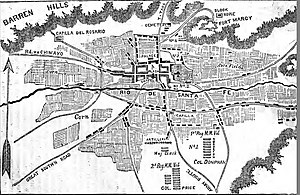Capture of Santa Fe
| Capture of Santa Fe | |||||||
|---|---|---|---|---|---|---|---|
| Part of the Mexican–American War | |||||||
 Doniphan's map[1] | |||||||
| |||||||
| Belligerents | |||||||
|
|
| ||||||
| Commanders and leaders | |||||||
|
|
| ||||||
| Strength | |||||||
| 1,700[2] | unknown | ||||||
The Capture of Santa Fe, also known as the Battle of Santa Fe or the Battle of Cañoncito, took place near Santa Fe, New Mexico, the capital of the Mexican Province of New Mexico, during the Mexican–American War on 8 August through 14 August 1846. No shots were fired during the capturing of Santa Fe.[2]
Background
[edit]United States Army General Stephen W. Kearny had moved southwest from Fort Leavenworth, Kansas with about 1,700 men in his Army of the West. Kearny's orders were to secure the New Mexico Territory and Alta California.[2]
August 9 in Santa Fe, Governor Manuel Armijo wanted to avoid battle, but Catholic priests, Diego Archuleta (the young regular-army commander), and the young militia officers Manuel Chaves and Miguel Pino forced him to muster a defense.[3] Armijo set up a position in Apache Canyon, a narrow pass about 10 miles (16 km) southeast of the city.[4] However, on August 14, before the American army was even in view, he decided not to fight. (An American named James Magoffin claimed he had convinced Armijo and Archuleta to follow this course;[5] an unverified story says he bribed Armijo.[6]) When Pino, Chaves, and some of the militiamen insisted on fighting, Armijo ordered the cannon pointed at them.[3] The New Mexican army retreated to Santa Fe, and Armijo fled to Chihuahua.
Capture
[edit]Kearny and his troops encountered no Mexican forces when they arrived on August 15. Kearny and his force entered Santa Fe and claimed the New Mexico Territory for the United States without a shot being fired.
Aftermath
[edit]From Santa Fe, Kearny sent Colonel Alexander Doniphan further south into Mexico. Kearny declared himself the military governor of the New Mexico Territory on August 18 and established a civilian government. He then took the remainder of his army west to Alta California.[2]
The New Mexicans put up no organized resistance until the Taos Revolt in early 1847, although in the month prior, a December, 1846 planned revolt in Santa Fe, involving many leading Mexican loyalists, was discovered and disrupted by General Sterling Price, after being informed of the plot by Donaciano Vigil, before it could be carried out.[7]
See also
[edit]- Battles of the Mexican–American War
- List of battles fought in New Mexico
- Taos Revolt – Insurrection in New Mexico Territory in 1847
Notes
[edit]- ^ Hughes, J.T., 1847, Doniphan's Expedition, Cincinnati:U.P. James, p. 37
- ^ a b c d "The Battle of Santa Fe". Early American Wars: A Guide to Early American Units and Battles before 1865. MyCivilWar.com. 2005–2008. Retrieved 2009-01-14.
- ^ a b Simmons, Marc (1973). The Little Lion of the Southwest: a life of Manuel Antonio Chaves. Chicago: The Swallow Press. ISBN 0-8040-0633-4.
- ^ "New Mexico Historic Markers: Canoncito at Apache Canyon". Archived from the original on 2007-09-27. Retrieved 2007-04-15. Includes a link to a map.
- ^ Keleher, William A. (1952). Turmoil in New Mexico 1846–1848. University of New Mexico Press. ISBN 0-8263-0631-4.
- ^ Beck, Warren A. (1962). New Mexico: A History of Four Centuries. University of Oklahoma Press.
- ^ Ralph Emerson Twitchell, The History of the Military Occupation of the Territory of New Mexico (1909) pp.310–321
References
[edit]- H. Bailey Carroll, The Texan Santa Fé Trail (Canyon, Texas: Panhandle-Plains Historical Society, 1951).
- Hubert Howe Bancroft; History of the North Mexican States and Texas, Volume 2: 1801–1889. Published in 1889 (index for volumes 15 and 16)
- Kearny's orders Library of Congress
